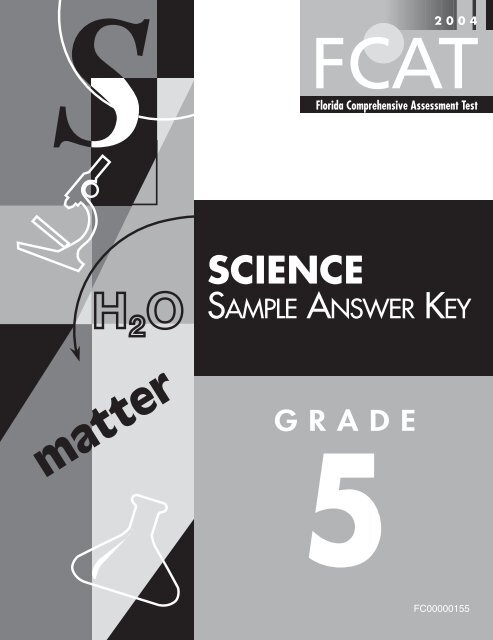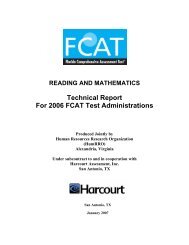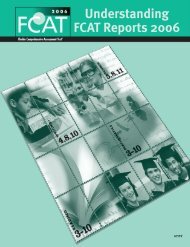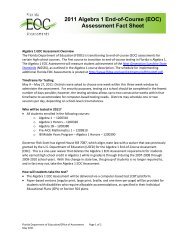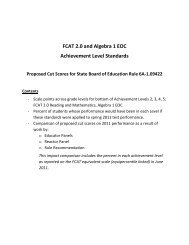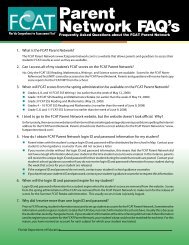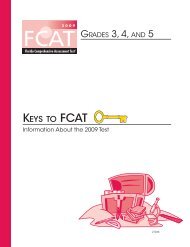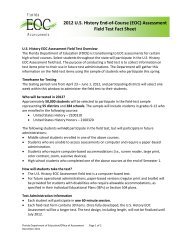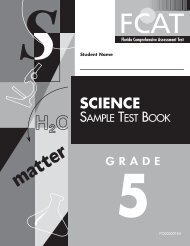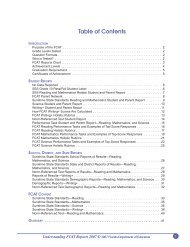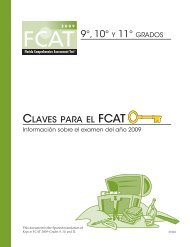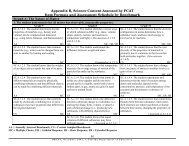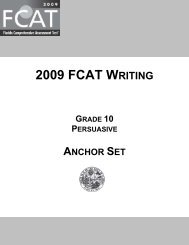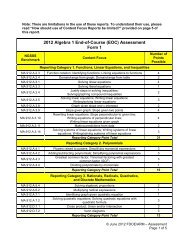FCAT SampleAns Key-Gr 5 - Bureau of K-12 Assessment - Florida ...
FCAT SampleAns Key-Gr 5 - Bureau of K-12 Assessment - Florida ...
FCAT SampleAns Key-Gr 5 - Bureau of K-12 Assessment - Florida ...
You also want an ePaper? Increase the reach of your titles
YUMPU automatically turns print PDFs into web optimized ePapers that Google loves.
2004<br />
SCIENCE<br />
SAMPLE ANSWER KEY<br />
matter<br />
GRADE<br />
5<br />
FC00000155
<strong>FCAT</strong> Sample Test Materials<br />
These sample test materials are designed to help students prepare to answer <strong>FCAT</strong><br />
questions. These materials introduce them to the kinds <strong>of</strong> questions they will answer<br />
when they take <strong>FCAT</strong> and include hints for responding to the different kinds <strong>of</strong><br />
questions. The <strong>FCAT</strong> Science sample test materials for <strong>Gr</strong>ade 5 are composed <strong>of</strong> the<br />
books described below:<br />
❏<br />
✓❏<br />
Sample Test Book<br />
Includes a science sample test and instructions for completing the sample test.<br />
(Copies are available for all students in the tested grade.)<br />
Sample Answer <strong>Key</strong><br />
Includes answers and explanations for the questions in the sample test. (Copies are<br />
available for classroom teachers only.)<br />
✓❏ = This book<br />
Copyright Statement for This <strong>Assessment</strong> and School Performance Publication<br />
Authorization for reproduction <strong>of</strong> this document is hereby granted to persons acting in an <strong>of</strong>ficial capacity within the Uniform System <strong>of</strong><br />
Public K–<strong>12</strong> Schools as defined in Section 1000.01(4), <strong>Florida</strong> Statutes. The copyright notice at the bottom <strong>of</strong> this page must be included in<br />
all copies.<br />
All trademarks and trade names found in this publication are the property <strong>of</strong> their respective companies and are not associated with the<br />
publishers <strong>of</strong> this publication.<br />
Permission is NOT granted for distribution or reproduction outside <strong>of</strong> the Uniform System <strong>of</strong> Public K–<strong>12</strong> Schools or for commercial<br />
distribution <strong>of</strong> the copyrighted materials without written authorization from the <strong>Florida</strong> Department <strong>of</strong> Education. Questions regarding use <strong>of</strong><br />
these copyrighted materials should be sent to the following:<br />
The Administrator<br />
<strong>Assessment</strong> and School Performance<br />
<strong>Florida</strong> Department <strong>of</strong> Education<br />
Tallahassee, <strong>Florida</strong> 32399-0400<br />
Copyright © 2003<br />
State <strong>of</strong> <strong>Florida</strong><br />
Department <strong>of</strong> State
<strong>FCAT</strong> Science <br />
Sample Answer <strong>Key</strong><br />
SAMPLE<br />
5<br />
This answer key contains answers to the <strong>FCAT</strong> Science sample test questions. It also gives the<br />
Sunshine State Standards benchmark assessed by each item on the sample test. In addition,<br />
possible approaches to solving the questions are provided. Students may use approaches other<br />
than these and still receive credit if they also obtain a correct answer. For multiple-choice items,<br />
the reason an answer choice is incorrect (distractor rationale) is also provided.<br />
Multiple-choice items are scored by awarding one point for each correct answer. The “Read,<br />
Inquire, Explain” questions allow for partial credit for some answers, even if they are not 100%<br />
correct. Answers will be scored and points will be given based on the completeness and correctness<br />
<strong>of</strong> the answers. If a portion <strong>of</strong> an answer is correct, a portion <strong>of</strong> the points may be awarded. The<br />
rubrics are printed on pages 2 and 3 <strong>of</strong> this book.<br />
Page 1<br />
<strong>FCAT</strong> 2004 Sample Test Materials, © 2003 <strong>Florida</strong> Department <strong>of</strong> Education
SAMPLE<br />
5 <strong>FCAT</strong><br />
Science Sample Answer <strong>Key</strong><br />
The scoring rubrics for the short-response questions and the extended-response questions are<br />
shown below:<br />
READ<br />
INQUIRE<br />
EXPLAIN<br />
Rubric for Short-Response Questions<br />
2 points A score <strong>of</strong> two indicates that the student has demonstrated a thorough<br />
understanding <strong>of</strong> the scientific concepts and/or procedures embodied in the<br />
task. The student has completed the task correctly, in a scientifically sound<br />
manner. When required, student explanations and/or interpretations are clear<br />
and complete. The response may contain minor flaws that do not detract from<br />
the demonstration <strong>of</strong> a thorough understanding.<br />
1 point A score <strong>of</strong> one indicates that the student has provided a response that is only<br />
partially correct. For example, the student may arrive at an acceptable<br />
conclusion or provide an adequate interpretation, but may demonstrate some<br />
misunderstanding <strong>of</strong> the underlying scientific concepts and/or procedures.<br />
Conversely, a student may arrive at an unacceptable conclusion or provide a<br />
faulty interpretation, but could have applied appropriate and scientifically<br />
sound concepts and/or procedures.<br />
0 points A score <strong>of</strong> zero indicates that the student has provided a completely incorrect<br />
or uninterpretable response, or no response at all.<br />
Page 2<br />
<strong>FCAT</strong> 2004 Sample Test Materials, © 2003 <strong>Florida</strong> Department <strong>of</strong> Education
<strong>FCAT</strong> Science Sample Answer <strong>Key</strong><br />
SAMPLE<br />
5<br />
READ<br />
INQUIRE<br />
EXPLAIN<br />
Rubric for Extended-Response Questions<br />
4 points A score <strong>of</strong> four indicates that the student has demonstrated a thorough<br />
understanding <strong>of</strong> the scientific concepts and/or procedures embodied in the<br />
task. The student has completed the task correctly, used scientifically sound<br />
procedures, and provided clear and complete explanations and interpretations.<br />
The response may contain minor flaws that do not detract from a<br />
demonstration <strong>of</strong> a thorough understanding.<br />
3 points A score <strong>of</strong> three indicates that the student has demonstrated an<br />
understanding <strong>of</strong> the scientific concepts and/or procedures embodied in the<br />
task. The student’s response to the task is essentially correct, but the scientific<br />
procedures, explanations, and/or interpretations provided are not thorough.<br />
The response may contain minor flaws that reflect inattentiveness or indicate<br />
some misunderstanding <strong>of</strong> the underlying scientific concepts and/or<br />
procedures.<br />
2 points A score <strong>of</strong> two indicates that the student has demonstrated only a partial<br />
understanding <strong>of</strong> the scientific concepts and/or procedures embodied in the<br />
task. Although the student may have arrived at an acceptable conclusion or<br />
provided an adequate interpretation <strong>of</strong> the task, the student’s work lacks an<br />
essential understanding <strong>of</strong> the underlying scientific concepts and/or<br />
procedures.<br />
The response may contain errors related to misunderstanding important<br />
aspects <strong>of</strong> the task, misuse <strong>of</strong> scientific procedures/processes, or faulty<br />
interpretations <strong>of</strong> results.<br />
1 point A score <strong>of</strong> one indicates that the student has demonstrated a very limited<br />
understanding <strong>of</strong> the scientific concepts and/or procedures embodied in the<br />
task. The student’s response is incomplete and exhibits many flaws. Although<br />
the student’s response has addressed some <strong>of</strong> the conditions <strong>of</strong> the task, the<br />
student has reached an inadequate conclusion and/or provided reasoning that<br />
is faulty or incomplete.<br />
The response exhibits many flaws or may be incomplete.<br />
0 points A score <strong>of</strong> zero indicates that the student has provided a completely incorrect<br />
solution or uninterpretable response, or no response at all.<br />
Page 3<br />
<strong>FCAT</strong> 2004 Sample Test Materials, © 2003 <strong>Florida</strong> Department <strong>of</strong> Education
SAMPLE<br />
5 <strong>FCAT</strong><br />
Science Sample Answer <strong>Key</strong><br />
1 The correct answer is B (Block B).<br />
Strand: A—The Nature <strong>of</strong> Matter<br />
Benchmark: SC.A.1.2.1 The student determines that the properties <strong>of</strong> materials (e.g.,<br />
density and volume) can be compared and measured (e.g., using rulers, balances, and<br />
thermometers).<br />
Answer Strategy:<br />
To determine which block has the greatest mass, look at each balance and compare the block<br />
with the identified mass. If the block tips the balance lower than the identified mass, it has more<br />
mass. If the block tips the balance higher than the identified mass, it has less mass. The block<br />
that tips the balance lower than 45 grams would have the most mass because this is the greatest<br />
mass identified. According to the balances, Block B’s mass is more than 45 grams while the<br />
masses <strong>of</strong> Blocks A, C, and D are equal to or less than 45 grams.<br />
Distractor Rationale:<br />
A. The mass <strong>of</strong> Block A is equal to 45 grams.<br />
C. The mass <strong>of</strong> Block C is less than 25 grams, which is less than 45 grams.<br />
D. The mass <strong>of</strong> Block D is equal to 25 grams, which is less than 45 grams.<br />
Page 4<br />
<strong>FCAT</strong> 2004 Sample Test Materials, © 2003 <strong>Florida</strong> Department <strong>of</strong> Education
<strong>FCAT</strong> Science Sample Answer <strong>Key</strong><br />
SAMPLE<br />
5<br />
2 The correct answer is H (mixture).<br />
Strand: A—The Nature <strong>of</strong> Matter<br />
Benchmark: SC.A.1.2.4 The student knows that different materials are made by<br />
physically combining substances and that different objects can be made by combining<br />
different materials.<br />
Answer Strategy:<br />
A mixture is comprised <strong>of</strong> several substances that are mixed together yet retain their original<br />
properties. When the ingredients are combined, a new material (cereal) is created yet the<br />
substances maintain their original properties.<br />
Distractor Rationale:<br />
F. A compound is a substance containing two or more elements in a fixed ratio.<br />
G. An element is a substance that cannot be broken down into other substances.<br />
I. In a solution, all substances are equally dispersed throughout a single phase (such as in a<br />
liquid phase).<br />
Page 5<br />
<strong>FCAT</strong> 2004 Sample Test Materials, © 2003 <strong>Florida</strong> Department <strong>of</strong> Education
SAMPLE<br />
5 <strong>FCAT</strong><br />
Science Sample Answer <strong>Key</strong><br />
3 The correct answer is D (to be a source <strong>of</strong> energy).<br />
Strand: B—Energy<br />
Benchmark: SC.B.1.2.1 The student knows how to trace the flow <strong>of</strong> energy in a<br />
system (e.g., as in an ecosystem).<br />
Answer Strategy:<br />
In this food chain, energy is transferred from one living thing to the next. When a living thing is<br />
eaten by something above it on the food chain, the living thing that consumes it absorbs its<br />
energy. Just as the rabbit gets energy from eating the carrot, the fox gets energy from eating the<br />
rabbit.<br />
Distractor Rationale:<br />
A. A habitat is a place where an organism lives. The rabbit does not help the fox or carrot to<br />
form a habitat. The rabbit is an energy source for the fox.<br />
B. The role <strong>of</strong> the rabbit is not to find a space for the fox or carrot to live. The rabbit is an<br />
energy source for the fox.<br />
C. The rabbit is not the primary source <strong>of</strong> water for the fox. Although water, as well as energy,<br />
is transferred, the fox’s primary source <strong>of</strong> water is not the rabbit.<br />
Page 6<br />
<strong>FCAT</strong> 2004 Sample Test Materials, © 2003 <strong>Florida</strong> Department <strong>of</strong> Education
<strong>FCAT</strong> Science Sample Answer <strong>Key</strong><br />
SAMPLE<br />
5<br />
4 The correct answer is F (light and heat).<br />
Strand: B—Energy<br />
Benchmark: SC.B.1.2.2 The student recognizes various forms <strong>of</strong> energy (e.g., heat,<br />
light, and electricity). (Also assesses SC.B.1.2.4 knows the many ways in which energy<br />
can be transformed from one type to another.)<br />
Answer Strategy:<br />
Energy is given <strong>of</strong>f in many forms. All objects always emit some radiation (energy). At room<br />
temperature or below, the amount <strong>of</strong> energy given <strong>of</strong>f is minimal. Only at much higher<br />
temperatures is the energy <strong>of</strong> the radiation (light) sufficient to make it visible. When the wick <strong>of</strong><br />
the candle burns, it produces the visible light energy and heat (the transfer <strong>of</strong> thermal energy<br />
from one substance to another).<br />
Distractor Rationale:<br />
G. Fire produces no sound, though burning objects do produce sound. Some chemical<br />
reactions do occur.<br />
H. Fire is not a source <strong>of</strong> magnetic or nuclear energy. Even though light is part <strong>of</strong> the<br />
electromagnetic spectrum, the magnetic component is too small to be useful.<br />
I. Fire is not a good source <strong>of</strong> electrical or mechanical energy. Even though light is part <strong>of</strong> the<br />
electromagnetic spectrum, the electrical energy (flow <strong>of</strong> electrons) is negligible.<br />
Page 7<br />
<strong>FCAT</strong> 2004 Sample Test Materials, © 2003 <strong>Florida</strong> Department <strong>of</strong> Education
SAMPLE<br />
5 <strong>FCAT</strong><br />
Science Sample Answer <strong>Key</strong><br />
5 The correct answer is A (friction).<br />
Strand: C—Force and Motion<br />
Benchmark: SC.C.2.2.4 The student knows that the motion <strong>of</strong> an object is determined<br />
by the overall effect <strong>of</strong> all <strong>of</strong> the forces acting on the object. (Also assesses SC.C.2.2.2<br />
knows that an object may move in a straight line at a constant speed, speed up, slow<br />
down, or change direction dependent on net force acting on the object.)<br />
Answer Strategy:<br />
Water affects friction. Water can create a smooth layer between two surfaces (e.g., the floor and<br />
the sole <strong>of</strong> a shoe) by filling in any gaps or holes in the rough surface. Molecules in a liquid<br />
slide past each other more easily than particles in a solid, thus providing lubrication. This<br />
reduces the amount <strong>of</strong> friction objects would normally experience as one rough surface rubs<br />
against another rough surface.<br />
Distractor Rationale:<br />
B. A wet floor does not affect gravitational force.<br />
C. A wet floor would provide lubrication, increasing inertia.<br />
D. Magnetism does not apply in this situation.<br />
Page 8<br />
<strong>FCAT</strong> 2004 Sample Test Materials, © 2003 <strong>Florida</strong> Department <strong>of</strong> Education
<strong>FCAT</strong> Science Sample Answer <strong>Key</strong><br />
SAMPLE<br />
5<br />
6 The correct answer is H (A flowing river cut into the rocks to form the canyon).<br />
Strand: D—Processes that Shape the Earth<br />
Benchmark: SC.D.1.2.4 The student knows that the surface <strong>of</strong> the Earth is in a<br />
continuous state <strong>of</strong> change as waves, weather, and shifts <strong>of</strong> the land constantly change<br />
and produce many new features. (Also assesses SC.D.1.2.1 knows that larger rocks can be<br />
broken down into smaller rocks, which in turn can be broken down to combine with<br />
organic material to form soil, SC.D.1.2.2 knows that 75 percent <strong>of</strong> the surface <strong>of</strong> the Earth<br />
is covered by water, and SC.D.1.2.5 knows that some changes in the Earth’s surface are<br />
due to slow processes and some changes are due to rapid processes.)<br />
Answer Strategy:<br />
Moving water erodes rock and soil over long periods <strong>of</strong> time. The different exposed layers <strong>of</strong><br />
rock in the <strong>Gr</strong>and Canyon today show that the river cut a path as it ran through the canyon,<br />
taking some soil and rock with it as it flowed and leaving the rest.<br />
Distractor Rationale:<br />
F. A waterfall would only erode rock at the waterfall site.<br />
G. Although rainstorms cause erosion, the canyon was formed as a result <strong>of</strong> thousands <strong>of</strong><br />
years <strong>of</strong> water erosion.<br />
I. Rocks from other locations could not have formed a canyon because a canyon is a result <strong>of</strong><br />
erosion, not a result <strong>of</strong> deposition.<br />
Page 9<br />
<strong>FCAT</strong> 2004 Sample Test Materials, © 2003 <strong>Florida</strong> Department <strong>of</strong> Education
SAMPLE<br />
5 <strong>FCAT</strong><br />
Science Sample Answer <strong>Key</strong><br />
7 The correct answer is A (There is a day and a night).<br />
Strand: E—Earth and Space<br />
Benchmark: SC.E.1.2.1 The student knows that the tilt <strong>of</strong> the Earth on its own axis as<br />
it rotates and revolves around the Sun causes changes in season, length <strong>of</strong> day, and<br />
energy available.<br />
Answer Strategy:<br />
It takes 24 hours for Earth to make a complete rotation on its axis. Because <strong>of</strong> this rotation, the<br />
Sun shines on different portions <strong>of</strong> Earth as it rotates, creating periods <strong>of</strong> day and night on the<br />
surface <strong>of</strong> the Earth.<br />
Distractor Rationale:<br />
B. One revolution results in approximately 365 days in an earth year.<br />
C. The phases <strong>of</strong> the Moon are a result <strong>of</strong> the relative positions <strong>of</strong> Earth, the Moon, and the<br />
Sun as Earth and the Moon together revolve around the Sun.<br />
D. Earth’s seasons are the result <strong>of</strong> its tilt and revolution around the Sun.<br />
Page 10<br />
<strong>FCAT</strong> 2004 Sample Test Materials, © 2003 <strong>Florida</strong> Department <strong>of</strong> Education
<strong>FCAT</strong> Science Sample Answer <strong>Key</strong><br />
SAMPLE<br />
5<br />
8 The correct answer is shown below.<br />
READ<br />
INQUIRE<br />
EXPLAIN<br />
Strand: E—Earth and Space<br />
Benchmark: SC.E.1.2.1 The student knows that the tilt <strong>of</strong> the Earth on its own axis as<br />
it rotates and revolves around the Sun causes changes in season, length <strong>of</strong> day, and<br />
energy available.<br />
Answer Strategy:<br />
Consider the position <strong>of</strong> Earth as it moves around the Sun to answer this question. The Sun<br />
remains visible 24 hours a day during the summer for the areas near the North and South Poles<br />
because <strong>of</strong> the direction Earth tilts as it revolves around the Sun. The pole tilted toward the Sun<br />
has sunlight all the time while the other pole that is tilted away from the Sun is dark all the<br />
time.<br />
To receive full credit (2 points) for this question, the response should include an explanation <strong>of</strong><br />
the tilt <strong>of</strong> Earth and the pole closest to the Sun receiving 24 hours <strong>of</strong> sunlight. Partially correct<br />
answers will receive a score <strong>of</strong> 1 point.<br />
Page 11<br />
<strong>FCAT</strong> 2004 Sample Test Materials, © 2003 <strong>Florida</strong> Department <strong>of</strong> Education
SAMPLE<br />
5 <strong>FCAT</strong><br />
Science Sample Answer <strong>Key</strong><br />
9 The correct answer is H (They can see well at night).<br />
Strand: F—Processes <strong>of</strong> Life<br />
Benchmark: SC.F.1.2.3<br />
similar structures.<br />
The student knows that living things are different but share<br />
Answer Strategy:<br />
A cat is a mammal and the owl is a bird, but both animals rely on their night vision for survival.<br />
Distractor Rationale:<br />
F. The owl is a bird, not a mammal.<br />
G. Eye color does not affect night vision.<br />
I. The cat has fur; the owl has feathers.<br />
Page <strong>12</strong><br />
<strong>FCAT</strong> 2004 Sample Test Materials, © 2003 <strong>Florida</strong> Department <strong>of</strong> Education
<strong>FCAT</strong> Science Sample Answer <strong>Key</strong><br />
SAMPLE<br />
5<br />
10 The correct answer is B (They have ways to protect themselves).<br />
Strand: G—How Living Things Interact with Their Environment<br />
Benchmark: SC.G.1.2.2 The student knows that living things compete in a climatic<br />
region with other living things and that structural adaptations make them fit for an<br />
environment.<br />
Answer Strategy:<br />
Even though both animals live in the same environment, the armadillo is a mammal and the<br />
coral snake is a reptile. The question explains how the animals use different techniques to<br />
protect themselves from their enemies: the armadillo curls up into an armored ball and the coral<br />
snake uses its tail to confuse its enemies. Though the techniques differ, both animals have ways<br />
to protect themselves.<br />
Distractor Rationale:<br />
A. Both animals live on land.<br />
C. Armadillos do not attack their enemies.<br />
D. Snakes do not have a hard outer layer <strong>of</strong> skin.<br />
Page 13<br />
<strong>FCAT</strong> 2004 Sample Test Materials, © 2003 <strong>Florida</strong> Department <strong>of</strong> Education
SAMPLE<br />
5 <strong>FCAT</strong><br />
Science Sample Answer <strong>Key</strong><br />
11 The correct answer is H (3).<br />
Strand: G—How Living Things Interact with Their Environment<br />
Benchmark: SC.G.1.2.3 The student knows that green plants use carbon dioxide,<br />
water, and sunlight energy to turn minerals and nutrients into food for growth,<br />
maintenance, and reproduction.<br />
Answer Strategy:<br />
<strong>Gr</strong>een plants release oxygen from their leaves into the atmosphere as a byproduct <strong>of</strong><br />
photosynthesis. Arrow 3 on the drawing goes from the leaves to the atmosphere.<br />
Distractor Rationale:<br />
F. Arrow 1 represents water and minerals moving from the soil into the roots.<br />
G. Arrow 2 does not represent a step in photosynthesis.<br />
I. Arrow 4 represents the carbon dioxide (CO 2 ) that goes from the atmosphere into the<br />
leaves.<br />
Page 14<br />
<strong>FCAT</strong> 2004 Sample Test Materials, © 2003 <strong>Florida</strong> Department <strong>of</strong> Education
<strong>FCAT</strong> Science Sample Answer <strong>Key</strong><br />
SAMPLE<br />
5<br />
<strong>12</strong> The correct answer is B (It must compete with other goldfish for resources).<br />
Strand: G—How Living Things Interact with Their Environment<br />
Benchmark: SC.G.2.2.1 The student knows that all living things must compete for<br />
Earth’s limited resources; organisms best adapted to compete for the available resources<br />
will be successful and pass their adaptations (traits) to their <strong>of</strong>fspring. [Also assesses<br />
SC.B.2.2.2 recognizes the costs and risks to society and the environment posed by the use<br />
<strong>of</strong> nonrenewable energy, and SC.B.2.2.3 knows that the limited supply <strong>of</strong> usable energy<br />
sources (e.g., fuels such as coal or oil) places great significance on the development <strong>of</strong><br />
renewable energy sources.]<br />
Answer Strategy:<br />
When living things are placed into new environments, in order to survive, they must compete<br />
for resources. The goldfish must compete with the other fish that are already in the tank to get<br />
the resources it needs to live.<br />
Distractor Rationale:<br />
A. The goldfish does not change its physical characteristics to camouflage itself.<br />
C. It would not allow other goldfish to use the limited resources first because the goldfish has<br />
to compete for resources to stay alive.<br />
D. A goldfish in an aquarium does not build a habitat.<br />
Page 15<br />
<strong>FCAT</strong> 2004 Sample Test Materials, © 2003 <strong>Florida</strong> Department <strong>of</strong> Education
SAMPLE<br />
5 <strong>FCAT</strong><br />
Science Sample Answer <strong>Key</strong><br />
13 The correct answer is G (write down what he sees in the jar).<br />
Strand: H—The Nature <strong>of</strong> Science<br />
Benchmark: SC.H.1.2.1 The student knows that it is important to keep accurate<br />
records and descriptions to provide information and clues on causes <strong>of</strong> discrepancies in<br />
repeated experiments.<br />
Answer Strategy:<br />
An understanding <strong>of</strong> experimental design is required to answer this question. To gain the most<br />
information from his experiment, Jim must track the results to draw appropriate conclusions<br />
and to have a record <strong>of</strong> the findings. Accurate notes also allow the experiment to be recreated in<br />
the future.<br />
Distractor Rationale:<br />
F. Adding more worms will not help Jim find out what worms do for a garden.<br />
H. Predictions should be made throughout the experiment, but keeping an accurate record <strong>of</strong><br />
observations is the most critical step.<br />
I. Planning should be completed before the start <strong>of</strong> the experiment.<br />
Page 16<br />
<strong>FCAT</strong> 2004 Sample Test Materials, © 2003 <strong>Florida</strong> Department <strong>of</strong> Education
<strong>FCAT</strong> Science Sample Answer <strong>Key</strong><br />
SAMPLE<br />
5<br />
14 The correct answer is shown below.<br />
READ<br />
INQUIRE<br />
EXPLAIN<br />
Strand: H—The Nature <strong>of</strong> Science<br />
Benchmark: SC.H.1.2.2 The student knows that a successful method to explore the<br />
natural world is to observe and record, and then analyze and communicate the results.<br />
(Also assesses SC.H.1.2.4 knows that to compare and contrast observations and results is<br />
an essential skill in science, and SC.H.3.2.2 knows that data are collected and interpreted<br />
in order to explain an event or concept.)<br />
Answer Strategy:<br />
Part A Robert’s experiment must include a way to measure the amount <strong>of</strong> force needed to lift<br />
the object each time he repositions the fulcrum. Robert also needs to decide how to measure the<br />
amount <strong>of</strong> force needed to lift the object with and without the lever. He should plan to do this<br />
several times with the fulcrum in different places and record the results.<br />
Part B The experiment could be improved by including a way to measure the amount <strong>of</strong> force<br />
needed to lift the object. That would show how the fulcrum placement affects the amount <strong>of</strong><br />
force needed. After determining how to measure the amount <strong>of</strong> force, then a comparison <strong>of</strong><br />
results is possible.<br />
To receive full credit (4 points) for this question, the response should include a complete<br />
description <strong>of</strong> the need for at least two <strong>of</strong> these elements <strong>of</strong> experimental design:<br />
• Measurement <strong>of</strong> force<br />
• Repetition<br />
• Record <strong>of</strong> results<br />
• Location <strong>of</strong> fulcrum<br />
Partially correct answers will receive a score <strong>of</strong> 1, 2, or 3 points.<br />
Page 17<br />
<strong>FCAT</strong> 2004 Sample Test Materials, © 2003 <strong>Florida</strong> Department <strong>of</strong> Education
SAMPLE<br />
5 <strong>FCAT</strong><br />
Science Sample Answer <strong>Key</strong><br />
15 The correct answer is D (It helps people by purifying the water to make it safer to<br />
use).<br />
Strand: H—The Nature <strong>of</strong> Science<br />
Benchmark: SC.H.3.2.1 The student understands that people, alone or in groups,<br />
invent new tools to solve problems and do work that affects aspects <strong>of</strong> life outside <strong>of</strong><br />
science. (Also assesses SC.H.3.2.3 knows that before a group <strong>of</strong> people build something<br />
or try something new, they should determine how it may affect other people.)<br />
Answer Strategy:<br />
Tap water in cities may come from different sources, but it all goes through a water purification<br />
process before it is tapped. This process involves removing potentially harmful elements<br />
(bacteria) and pollutants from the water by filtering them out or by using chemicals to kill<br />
them. This makes the water safer for humans to drink.<br />
Distractor Rationale:<br />
A. Factories may filter water for many reasons, but factories do not supply tap water for<br />
people in cities.<br />
B. The purification process does not increase the availability <strong>of</strong> water.<br />
C. The purification <strong>of</strong> water does not affect air quality.<br />
Page 18<br />
<strong>FCAT</strong> 2004 Sample Test Materials, © 2003 <strong>Florida</strong> Department <strong>of</strong> Education
<strong>FCAT</strong> Science Sample Answer <strong>Key</strong><br />
SAMPLE<br />
5<br />
16 The correct answer is I (variable).<br />
Strand: H—The Nature <strong>of</strong> Science<br />
Benchmark: SC.H.3.2.4 The student knows that through the use <strong>of</strong> science processes<br />
and knowledge, people can solve problems, make decisions, and form new ideas.<br />
Answer Strategy:<br />
The bucket with no added minerals represents the control in the experiment. The different<br />
minerals added to each <strong>of</strong> the other buckets represent the variables in the experiment. By<br />
comparing the growth <strong>of</strong> the chickens eating each type <strong>of</strong> altered feed (the variables) to the<br />
growth <strong>of</strong> the chickens eating unaltered feed (the control group), the farmer can determine if the<br />
added minerals affected animal growth.<br />
Distractor Rationale:<br />
F. A control is used as a basis <strong>of</strong> comparison for evaluation <strong>of</strong> the results. In this experiment,<br />
the control is the feed without added minerals.<br />
G. A hypothesis is a prediction based on observations. In this experiment, the hypothesis is<br />
minerals affect growth in chickens.<br />
H. A specimen is a sample that is used for testing or study. In this experiment, the chickens are<br />
the specimens.<br />
Page 19<br />
<strong>FCAT</strong> 2004 Sample Test Materials, © 2003 <strong>Florida</strong> Department <strong>of</strong> Education
Notes<br />
Page 20<br />
<strong>FCAT</strong> 2004 Sample Test Materials, © 2003 <strong>Florida</strong> Department <strong>of</strong> Education
Notes<br />
Page 21<br />
<strong>FCAT</strong> 2004 Sample Test Materials, © 2003 <strong>Florida</strong> Department <strong>of</strong> Education
<strong>Assessment</strong> and School Performance<br />
<strong>Florida</strong> Department <strong>of</strong> Education<br />
Tallahassee, <strong>Florida</strong><br />
Copyright © 2003 State <strong>of</strong> <strong>Florida</strong> Department <strong>of</strong> State


